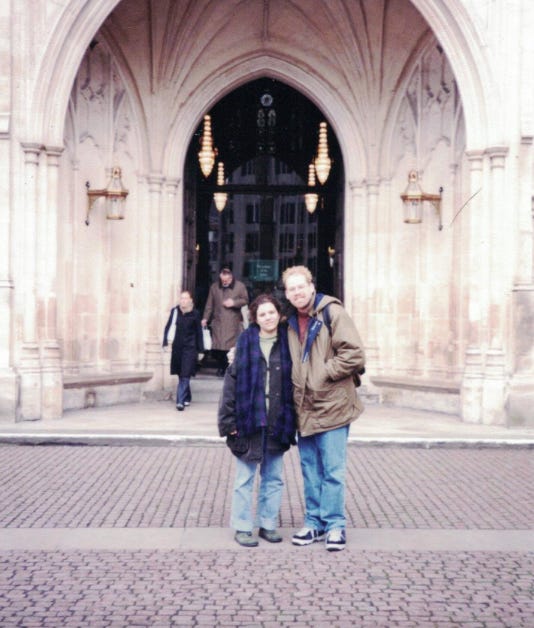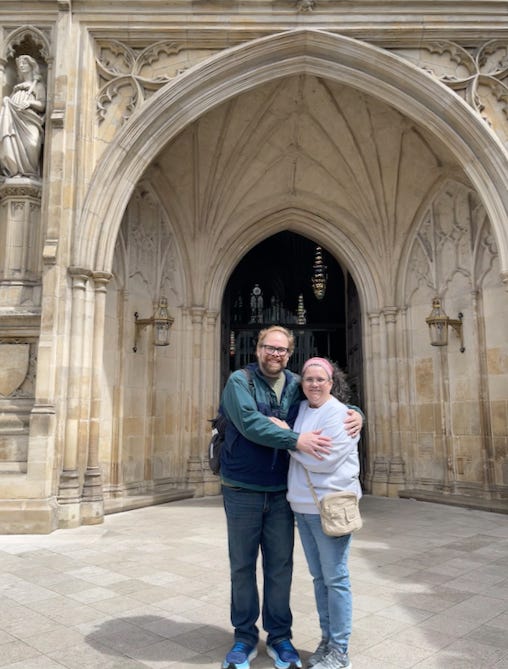Notes from an atheist attending a church service--that made him emotional.
I found myself reciting and responding with everyone else. The words came pouring out from somewhere in the deep recesses of my brain.
In March 2001, I proposed to my wife in Westminster Abbey.
I knew I would propose while we were in England, but I wasn’t sure how or when. I carried the ring in my pocket from the USA to London. One misty, cold morning, Amanda and I quietly escaped the group we were traveling with to visit Westminster Abbey. As we wandered through the cathedral, I realized this was the place–I just needed to figure out how. I knew that Poet's Corner, the burial place of many literary and musical icons, was an option. I thought this might be appropriate because Amanda was currently working on her Masters in creative writing and poetry. As we came to Poet’s Corner, I noticed anything we did would be very public, and, knowing Amanda, she would appreciate something a bit more private. I told her I wanted to sit down for a bit. We wandered and found some seats in the middle of the Cathedral, in front of the choir and low altar, and sat there quietly. It was quiet and personal, and I knew this was the moment. I was incredibly nervous, but I slid to my knee and asked my wife to marry me. At that moment, the pipe organ began to play in the background. Kismet is real, and I couldn’t have planned it any better.
We took a picture just outside the main entrance soon after.
We were both 26. I look back at this photo and am amazed at how young we were. Twenty-three years and a lifetime later, we revisited Westminster Abbey, this time with our kids, their partners, and our grandson.
Much had changed in 23 years–I don’t remember having to purchase tickets the first time we went. This time, it was jam-packed with tourists and cordoned-off lanes to guide traffic one way through the halls and corridors of the Abbey–it didn’t seem like the same quiet place of reflection that I remembered many years ago. In all fairness, though, my brain was preoccupied with things rather than enjoying the sights.
The abbey is awe-inspiring, with soaring arches and beautiful stained glass windows. It is grand and historical, and thousands of people–both famous and unknown–are buried there. But even with hundreds of people from all over the world and amidst the hustle of hundreds of people walking through the building, there is still an observable solemnity and quietness. As Amanda and I walked, we noticed Isaac Newton’s memorial and grave marker. Next to Newton was Stephen Hawking’s grave marker. A bell rang as I tried to get a picture of these tombstones, and a priest walked down the center aisle. They were starting their daily Holy Communion in the same place I proposed to Amanda many years ago.
Before we left for England, Amanda told me she wanted to attend services at either St. Paul’s Cathedral or Westminster Abbey. She asked if it would bother me if she were to attend. I have written about my journey to deconversion quite extensively in the past. After many years of uncertainty, I am finally able to comfortably say I am an atheist. That does not mean, however, that I can’t respect others beliefs and feelings. I understand its significance in history and other people’s lives, including my wife’s. It is just not significant to me anymore.
Of course I didn’t mind and told her I would also be happy to attend with her. Attending a service in either of these places is an experience unto itself, regardless of belief.
An usher began guiding people who wanted to participate into seats. Amanda joined the crowd and moved forward to sit, so I followed her. The order of service was printed on laminated sheets–I took one. I glanced over it, expecting it to differ from the Episcopal Rite One. It was almost identical. As the priest began, I found myself reciting and responding with everyone else. The words came pouring out from somewhere in the deep recesses of my brain.
As we went through the rite, my eyes began tearing up, and I got a lump in my throat.
This was very confusing to me. How could words that I have no credence in cause such an emotional response? 1
I read the words aloud with everyone else. But with a different conviction than I might have when I chose to believe in them. This time, I focused on the beauty and simplicity of the words. It was like when you recite a poem–I mean, really recite it. Not just read the words on the page. You put meaning into and behind the words the writer wrote. There is a power to the words, the cadence, and the meaning of the Order of Service. It is more than words on paper–these words have been repeated for centuries, adapted for the times, but they are still the same. Transcending time, they still carry significant meaning today. I can still hear the recitation of the exact words in the center of St. David's. Even though the church is gone, the words echo and resonate.
The ritual was familiar to me. The liturgy was familiar to me. The words were familiar to me. I’m sure the wine and bread would also taste familiar. However, out of respect, I chose not to partake of the Eucharist.
In Rite One, the very second collect is the verse that commands you first to love God and then love your neighbor as yourself—“On these two commandments hang all the Law…”
These words are about love—the very foundation of all Christianity that has metamorphosed into a distorted version of its original intent. To care for, be kind to, respect, and treat with dignity–no matter what. That is the love this passage talks about. That is the foundation for Rite One. And I was reminded about the beauty of true love. It also happened to be a few seats down from where I got on my knees and asked Amanda to be my wife.
A few weeks later, we were in Fort Williams in the Scottish Highlands. There was a church that, like all buildings in the UK, was old and dignified. Amanda and I were waiting for the others in our group, so we walked in.
In its own way, it is as magnificent as Westminster Abbey. Its stone construction, high arches, gold-inlaid mosaics, and stained-glass windows were as grand–just on a much smaller scale.
Amanda went to one of the pews and sat down while I wandered around admiring the stained glass. I picked up a hymnal by the door, and the book just happened to open to one of Amanda’s favorite hymns, the Episcopal classic Morning Has Broken. It brought back memories of us singing this very song in the sanctuary of our church a long time ago.
Later, in the car, I started thinking of the memories of my time in the Episcopal church. When Amanda and I got married, even though it was in a Methodist church, we used the rite from the Book of Common Prayer. Our kids were all baptized in the Episcopal church. We attended funerals in the Episcopal church. Our social lives revolved around the church. My oldest son and I completed the Confirmation process and were confirmed by the Episcopal church. Just because I don’t believe in the tenets of Christianity, there is no denying the Episcopal church was an integral part of my life—our lives—both ritualistically and memorably.
I did not mourn my decision. I accepted it as part of who I am.
This is why I cried.
And no, it wasn’t any sort of “conviction from God” in my heart…







Beautifully written.
We travel some parallel roads. Nice piece.